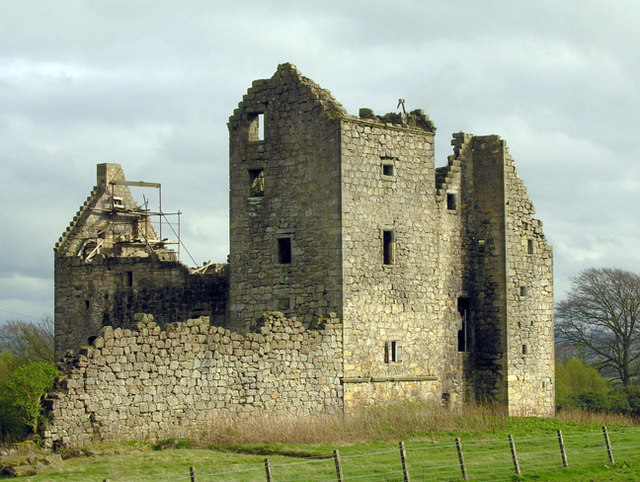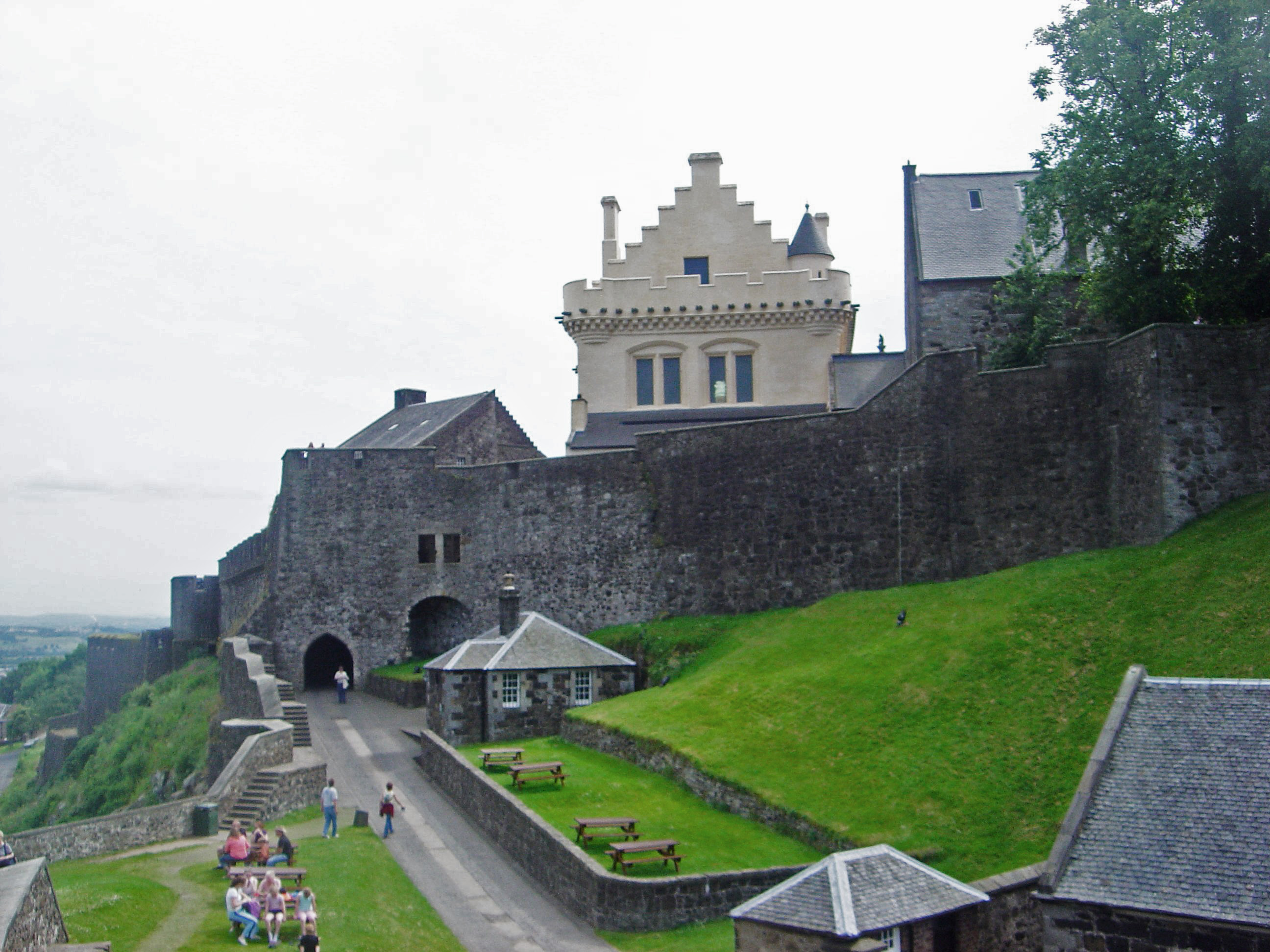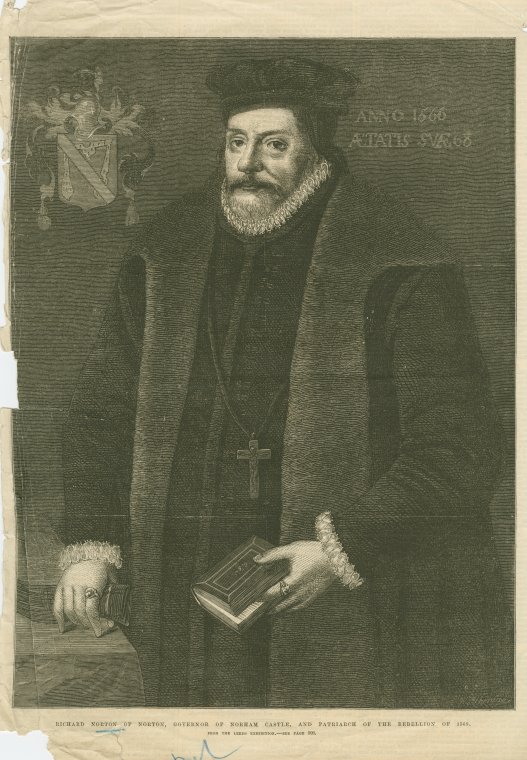|
Duncan Forestar
Duncan Forestar of Torwood and Skipinch was a Scottish courtier and financial administrator. He also served as Provost of Stirling. His family home was Torwood Castle near Stirling. "Skipinch" was an alternative name for Skipness Castle. James IV of Scotland gave him a barony of the lands of Skipness and the keepership of the castle on 3 July 1495. Duncan Forestar was also called "of Garden", from another property near Stirling. His son was Walter Forestar. Alexander Forrester of Garden was a member of a later generation of the same family. He was Comptroller of Scotland from 1492 to 1499 and from 1508 to 1509, serving James IV of Scotland. The Comptroller was in charge of collecting and spending royal revenue. In 1508 he was "Great Purveyor to the Queen" or "Magnus Provisor", in charge of purchasing food and other items for the household of Margaret Tudor, the wife of James IV. James Redheuch was the equivalent administrator for the king's household. For a time there were separ ... [...More Info...] [...Related Items...] OR: [Wikipedia] [Google] [Baidu] |
Torwood Castle
Torwood Castle is a ruined 16th-century L-plan castle near the village of Torwood, in the Falkirk Council area of central Scotland. It was designated as a Category A listed building in 1979. The Buildings at Risk Register for Scotland originally listed its level of risk as low, but raised that level to moderate in mid-2019 after seeing signs of continued neglect. History The estate was held originally by the Foresters of Garden, who were the foresters responsible for the nearby Royal Forest of Tor Wood from the second half of the 15th century until the mid-17th century. Based on the date found on a carved stone panel found not far from the castle in 1918, the castle has been estimated as being built around 1566 for Sir Alexander Forrester. It passed to Clan Baillie in the early 16th century and then to George, 1st Lord Forrester in 1635. The castle was captured prefatory to taking Stirling Castle during the 1585 successful rebellion of the Earls of Mar and Angus. The castle ... [...More Info...] [...Related Items...] OR: [Wikipedia] [Google] [Baidu] |
Skipness Castle
Skipness Castle stands on the east side of the Kintyre peninsula in Scotland, near the village of Skipness. Together with the nearby Kilbrannan Chapel it is a scheduled monument. History The main structure of the castle was built in the early 13th century by the Clan MacSween, with later fortifications and other additions made to the castle through the 13th, 14th and 16th centuries. The castle was garrisoned with royal troops in 1494, during King James IV of Scotland's suppression of the Isles. James IV appointed Duncan Forestar as keeper of the castle. Archibald Campbell, 2nd Earl of Argyll, granted Skipness to his younger son, Archibald Campbell, in 1511. During the Scotland in the Wars of the Three Kingdoms, Wars of the Three Kingdoms in 1646, the castle was besieged by forces under the command of Alasdair Mac Colla. During the siege, Alasdair's brother, Gilleasbuig Mac Colla, was killed in August 1646. The castle was abandoned in the 17th century. References External li ... [...More Info...] [...Related Items...] OR: [Wikipedia] [Google] [Baidu] |
James IV Of Scotland
James IV (17 March 1473 – 9 September 1513) was List of Scottish monarchs, King of Scotland from 11 June 1488 until his death at the Battle of Flodden in 1513. He inherited the throne at the age of fifteen on the death of his father, James III of Scotland, James III, at the Battle of Sauchieburn, following a rebellion in which the younger James was the figurehead of the rebels. James IV is generally regarded as the most successful of the House of Stuart, Stewart monarchs of Scotland. He was responsible for a major expansion of the Royal Scots Navy, Scottish royal navy, which included the founding of two royal dockyards and the acquisition or construction of 38 ships, including the ''Great Michael'', the largest warship of its time. James was a patron of the arts and took an active interest in the law, literature and science. With his patronage the Chepman and Myllar Press, printing press came to Kingdom of Scotland, Scotland, the University of Aberdeen and the Royal College o ... [...More Info...] [...Related Items...] OR: [Wikipedia] [Google] [Baidu] |
Alexander Forrester Of Garden
Alexander Forrester of Garden (floruit, fl. 1550–1599) was a Scottish landowner. He was the son of David Forrester of Torwood and Garden and Elizabeth Sandilands, daughter of James Sandilands of Slamannan. The name may be spelled "Forester" or "Forster". They were keepers of the royal Torwood Forest. In 1541 the Laird of Torwoodhead built a stable for the mares of James V of Scotland in the royal forest. Their home was Torwood Castle, where a datestone of "1566" suggests that Alexander Forrester built the remaining structure. "Garden" is near Arnprior, Stirling, Arnprior, several miles to the west of Torwood. Robert Beaton of Creich and "Alexander Forster, laird of Torwood" were both in Paris in October 1560 and carried letters from the English ambassador Nicholas Throckmorton to William Cecil, 1st Baron Burghley, William Cecil in London. Alexander Forrester was Burgh#Provost, Provost of Stirling in 1562 and 1565 and had a house in Stirling. On 21 March 1567 he witnessed and s ... [...More Info...] [...Related Items...] OR: [Wikipedia] [Google] [Baidu] |
Comptroller Of Scotland
The Comptroller of Scotland was a post in the pre-Union government of Scotland. The Treasurer and Comptroller had originated in 1425 when the Chamberlain's financial functions were transferred to them. From 1466 the Comptroller had sole responsibility for financing the royal household to which certain revenues (the property) were appropriated, with the Treasurer being responsible for the remaining revenue (the casualty) and other expenditure. Accounts were audited by and approved by the court of the exchequer. In the 1470s the court of the exchequer met at Falkland Palace yearly to finalise the accounts of the jointure lands of Mary of Guelders. By the 1530s the exchequer usually met in Edinburgh to audit and produce the accounts. Rooms were hired in the Blackfriars for the sessions. County sheriffs and other officials brought their reckonings to the exchequer. The accounts of the comptrollers were mostly in written in Latin, and were published as the '' Exchequer Rolls of Scotla ... [...More Info...] [...Related Items...] OR: [Wikipedia] [Google] [Baidu] |
Food And The Scottish Royal Household
Records survive of the expenses made to feed the Scottish royal household in the sixteenth century, and the remains of royal kitchens can be seen in the ruins of palaces and castles. Archaeologists can recover evidence of diet from deposits including waste from meals and food preparation. Overview Some of the remaining and ruined List of palaces#Scotland, Scottish royal palaces have kitchens, and the halls or chambers where food was served, and rooms where food and tableware were stored. There is an extensive archival record of the 16th-century royal kitchen in the series of households accounts in the National Records of Scotland, known as the ''Liber Emptorum'', the ''Liber Domicilii'' and the ''Despences de la Maison Royale'', which are daily records of the purchase of food and drink. The royal kitchens in the 1530s employed around 60 people. Supplies of food for the royal household were known as "furnishing" and were usually managed by the Masters of the Household. Charles II o ... [...More Info...] [...Related Items...] OR: [Wikipedia] [Google] [Baidu] |
Margaret Tudor
Margaret Tudor (28 November 1489 – 18 October 1541) was List of Scottish royal consorts, Queen of Scotland from 1503 until 1513 by marriage to King James IV. She then served as regent of Scotland during her son's minority, and fought to extend her regency. Margaret was the eldest daughter and second child of King Henry VII of England and Elizabeth of York, and the elder sister of King Henry VIII of England. By her line, the House of Stuart eventually acceded to the throne of Kingdom of England, England and Kingdom of Ireland, Ireland, in addition to Kingdom of Scotland, Scotland. Margaret married James IV at the age of 13, in accordance with the Treaty of Perpetual Peace between England and Scotland. Together, they had six children, though only one of them reached adulthood. Margaret's marriage to James linked the royal houses of England and Scotland, which a century later resulted in the Union of the Crowns. Following the death of James IV at the Battle of Flodden in 1513, M ... [...More Info...] [...Related Items...] OR: [Wikipedia] [Google] [Baidu] |
James Redheuch
James Redheuch, Redeheuch, Reidheugh, Riddoch, or Reddoch (died 1541) was a Scottish courtier. He was a burgess of Stirling and became a steward in the household of James IV of Scotland when he was prince (before the death of James III of Scotland. As Comptroller of Scotland from 1505 to 1509 and 1512 to 1513, and Chamberlain of Menteith and of Strathearn, Redheuch was in charge of revenues paid to James IV of Scotland. He was also a steward of the household from 1502 to 1510. Redheuch usually acted as an administrator the king's household, while Duncan Forestar of Garden was the equivalent comptroller of Margaret Tudor's household. In November 1503 he bought pewter water pots for the royal household. In October 1504, he organised carts to come to Dunfermline Palace to help evacuate Margaret Tudor and her English servants to Lindores Abbey because of a plague scare. The carts were not used, and Margaret and the " More Lassis" came to Edinburgh in November. Redheuch held variou ... [...More Info...] [...Related Items...] OR: [Wikipedia] [Google] [Baidu] |
National Records Of Scotland
National Records of Scotland () is a non-ministerial department of the Scottish Government. It is responsible for civil registration, the census in Scotland, demography and statistics, family history, as well as the national archives and historical records. National Records of Scotland was formed from the merger of the General Register Office for Scotland and the National Archives of Scotland in 2011; it combines all the functions of the two former organisations. The offices of Registrar General for Scotland and Keeper of the Records of Scotland remain separate, but since 2011 both have been vested ''ex officio'' in the Chief Executive of National Records of Scotland, currently Paul Lowe. Location National Records of Scotland is based in HM General Register House on Princes Street in the New Town in Edinburgh. The building was designed by Robert Adam for the Register House Trustees; it was opened to the public in 1788. History The first official tasked with the care ... [...More Info...] [...Related Items...] OR: [Wikipedia] [Google] [Baidu] |
Pedro De Ayala
Don Pedro de Ayala also Pedro López Ayala (died 31 January 1513) was a 16th-century Spanish diplomat employed by Ferdinand II of Aragon and Isabella I of Castile at the courts of James IV of Scotland and Henry VII of England. His mission to Scotland was concerned with the King's marriage and the international crisis caused by the pretender Perkin Warbeck. In his later career he supported Catherine of Aragon in England but was involved in a decade of rivalry with the resident Spanish ambassador in London. Ayala was a Papal prothonotary, Archdeacon of London, and Bishop of the Canary Islands. Sources in English reveal little of Ayala's background; however, he was from the noble family of the Counts of Fuensalida in Toledo. He was the son of Pedro Lopez de Ayala, Commendator of Mora and Treze, and Doña Leonor de Ayala. His contemporary, the historian Polydore Vergil, who may have known him in England, remarks that he was clever, but no scholar. Mission to Portugal In Novemb ... [...More Info...] [...Related Items...] OR: [Wikipedia] [Google] [Baidu] |
Perkin Warbeck
Perkin Warbeck ( – 23 November 1499) was a pretender to the English throne claiming to be Richard of Shrewsbury, Duke of York, who was the second son of Edward IV and one of the so-called "Princes in the Tower". Richard, were he alive, would have been the rightful claimant to the throne, assuming that his elder brother Edward V was dead and that he was Legitimacy (family law), legitimate—a point that had been previously contested by his uncle, King Richard III. Due to the uncertainty as to whether Richard had died (either of some natural cause or having been murdered in the Tower of London) or whether he had somehow survived, Warbeck's claim gained some support. Followers may have truly believed Warbeck was Richard or may have supported him simply because of their desire to overthrow the reigning king, Henry VII of England, Henry VII, and reclaim the throne. Given the lack of knowledge regarding Richard's fate, and having received support outside England, Warbeck emerged as ... [...More Info...] [...Related Items...] OR: [Wikipedia] [Google] [Baidu] |
Norham Castle
Norham Castle (sometimes Nornam) is a castle in Norham, Northumberland, England, overlooking the River Tweed, on the border between England and Scotland. It is a Grade I listed building and a Scheduled Ancient Monument. The castle saw much action during the wars between England and Scotland. Early history The castle was founded when Ranulf Flambard, Bishop of Durham from 1099 to 1128, gave orders for its construction in 1121 in order to protect the property of the bishopric in north Northumberland from incursions by the Scots. In 1136 David I of Scotland invaded Northumberland and captured the castle. It was soon handed back to the bishopric but was captured again in 1138 during another invasion. This time the structure of the castle was substantially damaged. It remained derelict until Hugh de Puiset, Bishop of Durham from 1153 to 1195, had the castle rebuilt. The work was probably directed by Richard of Wolviston, who was the bishop's architect. In 1174 Hugh de Puiset suppo ... [...More Info...] [...Related Items...] OR: [Wikipedia] [Google] [Baidu] |









